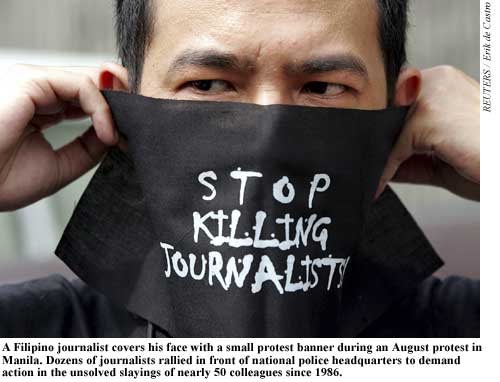New York, January 3, 2005—Even in a year of combat casualties brought on by war, murder remained the leading cause of work-related deaths among journalists worldwide in 2004, an analysis by the Committee to Protect Journalists has found.
Thirty-six of the 56 journalists who died in the line of duty in 2004 were murdered, continuing a long-term trend documented by CPJ. The organization’s annual year-end analysis reinforced another trend—the killers usually go unpunished. In all but nine cases in 2004, CPJ found, the murders were carried out with impunity.
The toll traverses the globe—from the Philippines, where eight journalists were slain in a shocking series of attacks; to Mexico, where drug-fueled violence claimed the lives of two journalists; to the Gambia, where editor and press freedom advocate Deyda Hydara was gunned down just days after denouncing a repressive new press law.
Even in Iraq, where crossfire was the leading cause of death among journalists, at least nine of the 23 journalists killed were deliberately targeted.
“The sheer number of journalists killed in 2004 is cause for deep concern,” CPJ Executive Director Ann Cooper said. “But the fact that so many were murdered with impunity is shameful and debilitating. Governments have an obligation to pursue and prosecute those responsible. By failing to do so, they let criminals set the limits on the news that citizens see and read.”
Most of the journalists killed around the world each year are local reporters, photographers, editors, and camera operators covering events in their own countries, according to CPJ research. In 2004, nine of the 56 journalists killed were foreign correspondents, and only one was American. Forbes Russia editor Paul Klebnikov, a U.S. citizen, was gunned down in Moscow in July, making him the 11th journalist killed in a contract-style murder since President Vladimir Putin came to power just five years ago.
Some high-risk spots shifted in 2004. While eight journalists were killed in Latin America—including two on the U.S./Mexico border and two in Nicaragua—no journalist was killed for his or her work in Colombia for the first time in at least a decade. Colombian journalists told CPJ that dozens of murders over two decades have seeded fear among provincial reporters, causing them to avoid sensitive coverage of the ongoing civil war.
As CPJ reported in December, the 2004 death toll is the highest in a decade. The deadliest year for journalists since CPJ began compiling detailed statistics was 1994, when 66 journalists were killed, mostly in Algeria, Rwanda, and Bosnia-Herzegovina.
Seventeen media workers were also killed in 2004, 16 of them in Iraq. Such workers play supporting roles as drivers, interpreters, fixers and guards. Two journalists also went missing, including French and Canadian journalist Guy-André Kieffer who disappeared in Ivory Coast in April.
CPJ considers a journalist to be killed on duty if the person died as a result of a hostile action, including retaliation for his or her work, in crossfire while covering a conflict, or while reporting in dangerous circumstances such as a violent street demonstration. It does not include journalists killed in accidents, or those who died of health ailments.
CPJ continues to investigate the cases of 17 other journalists killed in 2004 to determine whether their deaths are related to their journalistic work. CPJ staff has compiled detailed information on journalists killed around the world since 1992. Statistical information is available on CPJ’s Web site.
To review the list of journalists killed in 2004.
For a list of media workers killed in 2004
For an analysis of casualties in Iraq.
And to review journalists killed over the last decade.
![]()
